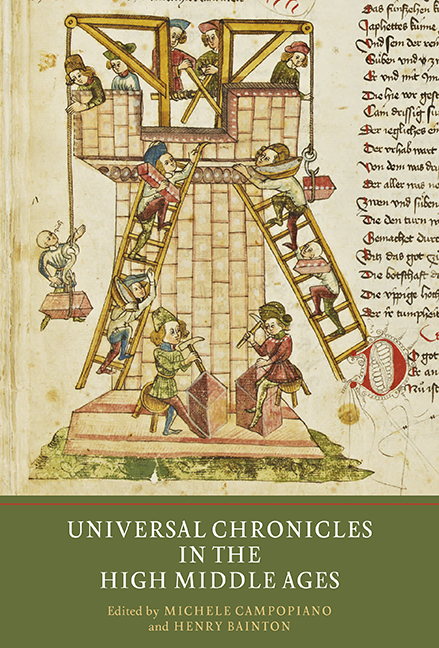Book contents
- Frontmatter
- Contents
- List of Illustrations
- Dedication
- Contributors
- Introduction: New Perspectives on Universal Chronicles in the High Middle Ages
- 1 The First Islamic Chronicle: The Chronicle Of Khalīfa B. Khayyāṭ (d. AD 854)
- 2 Universal Historiography as Process? Shaping Monastic Memories in the Eleventh-Century Chronicle Of Saint-Vaast
- 3 Writing Universal History in Eleventh-Century England: Cotton Tiberius B. i, German Imperial History-writing and Vernacular Lay Literacy
- 4 Political Didacticism in the Twelfth Century: the Middle-High German Kaiserchronik
- 5 Cosmology, Theology of History and Ideology in Godfrey of Viterbo's Pantheon
- 6 Écrire l'histoire universelle à la cour de Konrad IV de Hohenstaufen : la Weltchronik de Rudolf von Ems (milieu du XIIIe siècle)
- 7 Écrire la première histoire universelle en français: l'Histoire ancienne jusqu’à César de Wauchier de Denain et l'adaptation du modèle latin de l'histoire universelle à un public de laïcs
- 8 How Unusual was Matthew Paris? The Writing of Universal History in Angevin England
- 9 The Pillars of Hercules: The Estoria De Espanna (Escorial, Y.I.2) as Universal Chronicle
- 10 La vie d'Alexandre dans la Chronique dite de Baudouin d'Avesnes
- 11 Universal Histories and their Geographies: Navigating the Maps and Texts of Higden's Polychronicon
- Index
- Writing History in the Middle Ages
6 - Écrire l'histoire universelle à la cour de Konrad IV de Hohenstaufen : la Weltchronik de Rudolf von Ems (milieu du XIIIe siècle)
Published online by Cambridge University Press: 23 June 2018
- Frontmatter
- Contents
- List of Illustrations
- Dedication
- Contributors
- Introduction: New Perspectives on Universal Chronicles in the High Middle Ages
- 1 The First Islamic Chronicle: The Chronicle Of Khalīfa B. Khayyāṭ (d. AD 854)
- 2 Universal Historiography as Process? Shaping Monastic Memories in the Eleventh-Century Chronicle Of Saint-Vaast
- 3 Writing Universal History in Eleventh-Century England: Cotton Tiberius B. i, German Imperial History-writing and Vernacular Lay Literacy
- 4 Political Didacticism in the Twelfth Century: the Middle-High German Kaiserchronik
- 5 Cosmology, Theology of History and Ideology in Godfrey of Viterbo's Pantheon
- 6 Écrire l'histoire universelle à la cour de Konrad IV de Hohenstaufen : la Weltchronik de Rudolf von Ems (milieu du XIIIe siècle)
- 7 Écrire la première histoire universelle en français: l'Histoire ancienne jusqu’à César de Wauchier de Denain et l'adaptation du modèle latin de l'histoire universelle à un public de laïcs
- 8 How Unusual was Matthew Paris? The Writing of Universal History in Angevin England
- 9 The Pillars of Hercules: The Estoria De Espanna (Escorial, Y.I.2) as Universal Chronicle
- 10 La vie d'Alexandre dans la Chronique dite de Baudouin d'Avesnes
- 11 Universal Histories and their Geographies: Navigating the Maps and Texts of Higden's Polychronicon
- Index
- Writing History in the Middle Ages
Summary
This chapter continues this book's reflections on historiographical writing in the imperial milieu. It focuses on Rudolf of Ems's Weltchronik, written in the first half of the thirteenth century and dedicated to King Konrad IV, the son of the emperor Frederick II of Hohenstaufen. The Weltchronik is a crucial work in the development of Middle High German historiography. This chapter interrogates its social background (including Rudolf's close ties with the Hohenstaufen family), exploring the traces it left in the author's organization of his material. The chapter delineates some characteristics of early vernacular historiography in the Empire to show how it asserted itself in relation to Latin literature.
L'exposé qui suit consiste en une présentation, nécessairement tres incomplete, de la premiere chronique universelle rimée en langue allemande affichant l'ambition d'englober l'ensemble de l'histoire de l'humanité ainsi qu'un véritable savoir encyclopédique. Deux textes, l’Annolied composé vers la fin du XIe siecle et dont la réception fut probablement assez limitée, et la Kaiserchronik, beaucoup plus célebre que ce dernier et datée de 1150 environ, lui ont ouvert la voie. La Weltchronik de Rudolf von Ems est a peu pres contemporaine de la Sächsische Weltchronik, en prose, et de la Christherre-Chronik, dont la perspective est plus clairement théologique. Bien que restée a l’état de fragment, elle témoigne d'une ambition sans précédent dans le domaine de l'historiographie en langue vernaculaire, ce qui s'explique en grande partie par le fait que son commanditaire, Konrad IV, appartenait a une brillante dynastie royale, celle des Hohenstaufen, qui fut aussi la plus controversée de son temps. Cette image a double face de la dynastie souabe n'est sans doute pas étrangere a son succes: le texte de Rudolf a été l'objet d'un intéret sans cesse renouvelé, non seulement au Moyen Âge ou il engendra une tradition historiographique tres riche, par le biais de nombreuses compilations incluant la Christherre-Chronik et la Weltchronik du Viennois Jans Enikel, et dont la Weltchronik attribuée a Heinrich von München est, au xive siecle, l'un des représentants les plus spectaculaires, mais aussi a l’époque contemporaine, dans la recherche, ou elle a suscité des études tres denses.
- Type
- Chapter
- Information
- Universal Chronicles in the High Middle Ages , pp. 141 - 178Publisher: Boydell & BrewerPrint publication year: 2017

